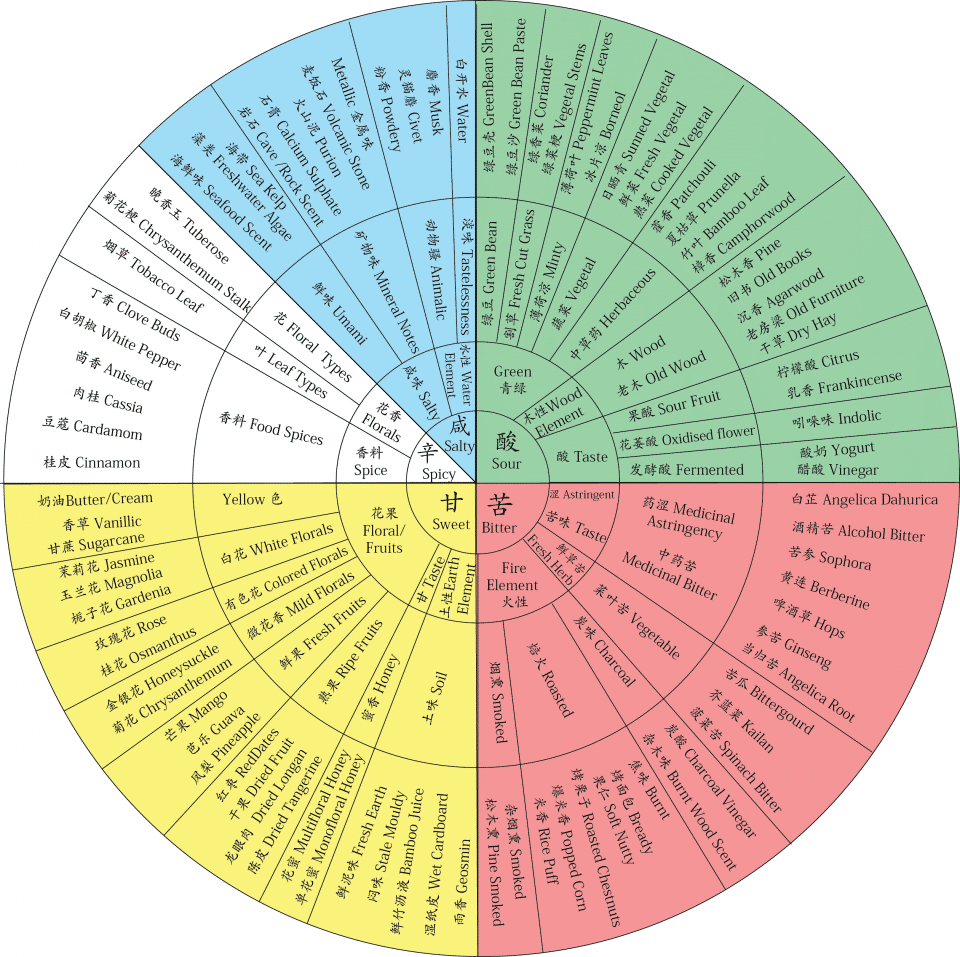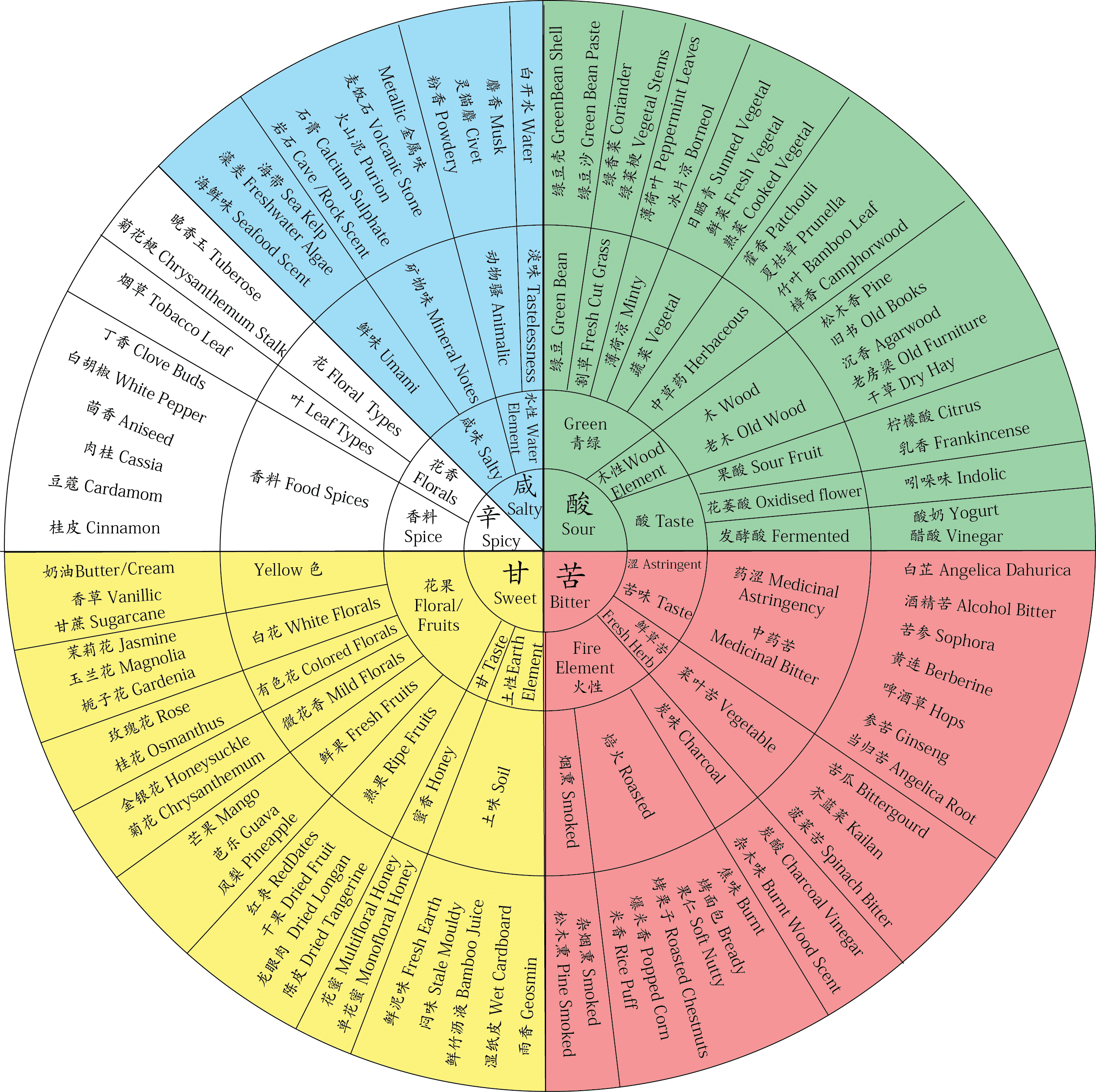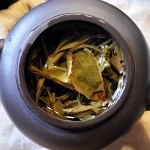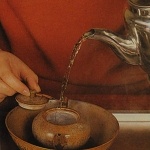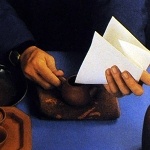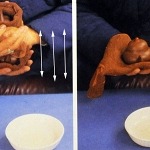The Tea Wheel.
The KZ Tea Wheel was developed from scratch rather than having had ripped it off other wine and beverage type of wheels. It too about a year’s conceptualization and testing, and by no means is an “absolute” wheel as everyone’s from different ethnicities, different olfactory and taste sensitivity/taste preferences etc. You can actually use this tea wheel as a base and adjust it if need be.
Why the need for a Tea Wheel? That is because tea is always constantly evolving, the processing methods, cultivars, weather, farming methods, storage, brewing, has always been changing, and these matters are often battered by the issue of margins and money. To this end, the identities and original flavours of tea is now increasingly lost, and there must be a new way to start describing tea flavours and fragrances in words, rather than using terms like “Tieguanyin taste, Long Jing taste etc”. Even Wuyi famous tea master, whom had passed on a few years ago, Zhang Tian Fu has said that in the later years.. he can almost no longer taste the 品种香 in tea.
In tasting tea or appreciating fragrances, it is all about the types of associations, the degrees of association and the intensities, transitions and interplay between the notes. But before even going into the complex interplay/evolvement of notes, getting to know the basics is paramount.
In this Tea Wheel, I had used the foundation of Five elements from Yi Jing, to which at least five basic tastes of Sweet, Sour, Bitter, Spicy, Salty, and the two other Astringent, Tastelessness, can be extrapolated into a myriad of different traits and associations. One of the most profound and reliable chinese five element systems being used in tea appreciation (particularly chinese tea), should be rather apt.
To use this wheel, you need to know the associations for each of the components, and there are commercial substances or materials you can acquire that can help you develop the taste/olfactory “reference”. In analysing a tea, you will start to use the wheel to map out its fingerprint, that is the various notes present, and the various intensities.
Records can help you track how a tea’s evolving in storage, in different brewing methods, samples of same tea from different processing, or different cultivars.
Note Description
In the Element of Wood / Sour / Green, we have 3 divisions, division 1 is being Green, that is greenness in colour association or taste association. To this end we have
- Green Bean Shell Taste, which is the typical mung bean that has been boiled into a soup but not to the points of the beans bursting. This Green Bean Shell Taste is often found in good quality Lung Jing Tea.
- Green Bean Paste taste, this is a bit more towards a pastey, cooked, possibly, sweet potatoish scent/taste that occurs if you too aggressively steep some tender leaves. Usually is a note from a mistake in brewing, or if the harvest leaf is too tender.
- Freshly Cut Grass notes i.e. Coriander – this is a lush green, aldehydelic notes reminiscent of coriander leaves, this is sometims transiently perceived in old tree green pu-erhs
- Freshyl Cut Grass in Vegetal Stems.- this is to describe a degree of green rawness, especially in green oolongs from taiwan, or green leafy teas from china.
- Minty taste – Peppermint leaves – this minty taste can be found in hints in certain aged Wuyi Qi Lan, or certain aged raw pu-erh.
- Minty in form of Borneol – This is some what camphoracious, but missing the woodiness, generally a cool/cold refreshing feel in the mouth, especially with good raw sheng pu-erhs.
- Vegetal – Sunned Vegetal notes – this is most commonly found in sun-withered green pu-erh teas. it is a unique metallic, green, vegetal note. You can create this by putting some green tea or light oxidized oolong in a clear glass jar and have it exposed to light for a week or so. This taste is probably due to magnesium or metal ion fall out from the chlorophyll pigments. Usually tea tasters pursue this note in new green pu-erh to ensure that the processing was done traditionally.
- Vegetal – Fresh Vegetal – this note is lively, crisp, lush, you can find this note in fresh green teas particularly Japanese sencha and gyokuro, and in some other chinese greens like Taiping Houkui.
- Vegetal – Cooked Vegetal notes – this note is easy to identify, it is just a vegetable soup, often because one oversteeps in too hot water for green oolongs that are thin leafed, i.e. jinxuan, sijichun, etc, or other chinese greens. The delicate fragrances/nuances are gone, with the overall taste/scent replaced by a cooked vegetal taste. To experience this you can put some green oolong into a thermos flasks and load in boiling water, let the tea steep for hours before you taste it.
- Herbaceous – Pachouli – This is a stemmy, herbaceous note that can appear in aged fine leaf pu-erhs, or small aged green puerh tuochas, the small 1993 tuocha from He Jian of Ye Tang, in taiwan, has this note well presented. Certain Ripe pu-erh tea bricks of traditional processing, can also present this note. You can buy this herb or essential oil as a references
- Herbaceous – Prunella leaf. This can also be bought from a chinese medicine source/shop, this taste often appears in aged oolong tea, and to which many would describe as “medicinal fragrance”.
- Herbaceous – Bamboo Leaf – This note is the taste of bamboo leaf tea, or dried bamboo leaves, often found in aged Liu An, well stored Liubao/Raw Pu-erhs.
- Wood – Pine – this is a resiny, terpenic note that is often found in well pine smoked Lapsang
- Wood – Old Books – This is the scent of aged paper, an old library, hints of vanillic compounds, ferfural, etc. This is a well desired taste in well aged pu-erh and is often described as “aged taste”
- Wood – Agarwood – a woody, heavy, calming, vanillic tone. You will know this note well if you have had tea with kynam or brunei agarwood or other good agarwoods. This is desirable in aged teas.
- Old Furniture note – This is a rather stoic, heavy, non volatile note that is found at the base of aged teas. It is the scent of good old chinese furniture, a heavy note from old rosewood or pterocarpus santlinus. Some good 8582 or aged tea stems have this clear note.
- Dry Hay – A fibrous, dry, wispy note, this can be found in some aged teas, some white teas or teas with quite a bit of stems or twigs.
- Taste – Sour Fruit – Citrus – the lemon juice acidity typically in aged tea in the first few washes, or if poorly kept or poorly processed ripe tea. This is commonly found Wuyi Cliff Tea that is aged for quite a while, without any re-roasting.
- Frankincense – the powdery, citrusy notes (fragrance only, not taste), in teas reminscent of good green Hojari Frankincense from Oman. can be found in some tie guanyins and raw pu-erhs
- Oxidized Flower – Indolic – This is the scent of gardenia, ylangylang, jasmine, but wilted, no longer bold and brash, but wispy and tail end, typically appearing at the end of a sip of tea after swallowing and pushing the air out of nose.
- Fermented – Yogurt – typically not a good note, often in badly stored tea or ripe pu-erh that is not processed properly.
- Fermented – Vinegar – same as above, it does occur with a certain amount of hint on poorly damp stored tea or badly processed ripe pu-erh
The Red Sector is divided into Bitterness, Astrigency of taste, and the Fire Element
- Bitter – Medicinal Astringency angelica dahurica – this is a very sharp type of astringency, almost pungent, typically in Sheng that is not processed for immediate drinking. To some, such astringency can hint some trace of pesticides etc but this is yet to be verified.
- Alcohol bitter – This type bitterness is common in strong sheng pu-erh like a good lao banzhang etc the bitterness is intense like a vodka, but upon gulping it down, it immediately disappears, and you feel this surge of “warmth”
- Sophophora – 苦参, The bitterness of this is strong and consistently strong in the mouth going a way only after a while. It goes away only after a few times you swallow saliva.
- Bitter – Medicinal Bitter – berberine – This is the most intense bitterness, it stays and does not go away. you can buy some 黄连 from a chinese medicine shop to taste this incredible bitterness. If a tea presents this, there’s a high chance that it is not processed properly, from the wrong seasons, and can cause stomach discomforts.
- Hops – A Clear fast fading bitterness, not as fast as alcohol, but more like the hops in beer, the bitterness declines with a fast slope, refreshing to the palate.
- Ginseng – it can be used to describe the ginseng fragrance in some aged teas, but in this case, it can be more used to describe the liquorice like nature of ginseng, the bitterness in the tea is not strong, and with some mildness, it quickly turns into a sweet tone on the tongue.
- Angelical root – The tea is generally not bitter, but upon swallowing, it leaves an edge of bitter discomfort texture, like little hooks on the tongue.
- Fresh herb VEGETAL bitter – bitter goard – This is typically green, lush juicy and crisp bitterness, it fades away quicker than hops. Can be extremely enjoyable.
- Kailan bitter – This is the typical bitterness of vegetal stems, it does not appear upfront, but in the middle to end when drinking.
- Spinach bitter – This is typically not bitter in the front, but a metallic, watery texture, the feeling is most apparent at the side/edges of the tongue.
- Fire element – Charcoal – Vinegar – This is the hint of BBQ sauce type of charcoal vinegar note, it can be found in some sheng pu-erh or some smoked teas such as a heavy smoke lapsang.
- Burnt Wood Scent – This comes in the form of woody smoke tones especially if tea is roasted with not high quality charcoal.
- Roasted notes – Burnt – This is the typical note that happens when a tea is over-roasted or carbonized during roasting. you can put some tea into a pan and roast till it becomes crispy and slightly burnt to know this note. it can be a processing flaw in oolong teas, handmade teas, or teas such as houji tea or bancha roasted.
- Bready – The bready note is rather obvious in over-roasted teas that have been allowed to rest for long time. it is the taste/scent of a soggy baguette.
- Soft Nutty – can be found or tasted in teas that are well roasted and then stored for a while, whilst roaste recedes, a soft nutty note, a creamy texture appears in the first two steeps of the tea.
- Roasted Chestnuts – a fuller, roasted chest nut note that can be found in traditional heavy roasted tie guanyin or similar oolongs.
- Popped Corn – hints of this is often found in roasted taiwanese teas that are rolled into balls, more commonly in the rinse. usually from electrical roastings.
- Rice Puff – a subtle quiet rice puff note, in teas that are electrically roasted, typically if they are greener oolongs.
- Smoked – Smoked – messy, tobacco, bad smokiness.
- Pine SMoked – common in lapsang souchong, but do take note of the need of the presence of the hint of pine terpenic notes to be properly pine smoked.
- Sweet – floral/fruits – yellow – butter cream – in high mountain oolongs, typically in the first two steeps (including the wash/rinse) the typical type of milkiness people can find in high mountain jin xuan etc.
- Vanillic – like vanilla sweetness, mid tone, full bodied. found in many good aged teas.
- Sugarcane – A sweet, sugarcane juice/stem/molasses note that is a central theme to Yiwu raw pu-erh region, or some of the medium grade bingdao pu-erh teas
- White florals – jasmine – a clear indolic note, full, lush, common in jasmine scented teas, and also in good tieguanyin’s 后韵
- Magnolia – a classic deep floral that is a desired trait in good oolong teas.
- Gardenia – a white, deep, narcotic floral, common in dancong experiences.
- Coloured florals – rose – citrusy, powdery, floral
- Osmanthus – rich, mid low toned, apricot, peachy note.
- Mild florals – honey suckle – a wispy, light note common in white teas
- Chrysanthemum – the hint of chrysanthemum flower petals or stems.
- Fresh fruits – mango – a rare note in teas, but can be sometimes found in fruity well oxidized taiwanese black/red teas.
- Guava – a ripe pink guava note can appear in good tieguanyin or dongding oolong that is well fermented.
- Pine apple – occurs in well fermented taiwanese teas that have been mildly roasted.
- Ripe Fruits – red date – a note found in riped pu-erh teas of decent quality
- Dried Fruit – a rich fruity note that is almost sweet to the nose, in deep fermented oolongs
- Dried Longan – typically a hint of it comes in charcoal roasted oolong teas
- Dried Tangerine – a powdery tone that is found in aged oolongs
- Taste sweet- honey – typically clearly sweet, honeyed note, in that of black/red teas such as gushu red teas, taiwan sun moon lake black teas, etc.
- Multifloral honey – instead of a clear honeyed note, this note takes on some complexity like a multifloral honey, i.e. in bug bitten teas such as darjeelings, taiwanese oolongs etc.
- Soil element – Fresh Earth – can be present in post processed shu-pu-erh tea, or damp storage liubao etc.
- Stale mouldy – typical mouldy, almost bad taste in tea that is poorly stored.
- Bamboo juice – a bamboo leafy note, in good and clean stored aged teas
- Wet cardboard – a damp note that is found in ripe tea but not mouldy scent yet
- Geosmin – the scent of rain hitting the earth.. the “water” note, humans are incredibly sensitive to this note at one part per trillion.. if you store water in a earthern vessel you will taste this easily.
- SPICY – florals – floral types – tuberose – the sort of spicy floral in many black or red teas
- Chrysanthemum stalk – a green spicy note found in floral stems, is found in quite a few raw pu-erhs or certain green teas like tian mu qing ding, etc.
- Leafy types – tobacco leaf – something common in smoky sheng pu-erhs like some xiaguans.
- Spice – food spices – cloves – this typically used to describe the plummy notes in some aged oolongs.. a hint of clove’s middle note.
- White pepper – not very common, but can be found in some green teas.
- Aniseed – a hollow note, a brief hint typically in menghai teas
- Cassia – rou gui, a cinnamon note but with that of sweet grass type of coumarin tone. gold standard in wuyi rougui.
- Cardamom – a fruity, citrus peel, spicy, note
- Cinnamon – the cinnamon note, sweet, spicy, but without coumarin tones. found in some dancongs
- Salty – Water element – Tastelessness – water – when tea starts to thin out and become invisible, it is almost like drinking water. the water note appears when a tea loses its presence.
- Animalic – Musk – typically siberian musks, in quite several hand made wuyi teas that are well roasted and aged.
- Civet – a fruity, esterified note. not referring to the fecal tail end, just the beginning… people seek out this note in kopi luwak, but in some strong floral fruity oolongs with deep fermentation, there is a hint.
- Powdery – this powder is like baby powder type of powdery. perhaps musky type of powdery too. usually in the first rinse of well roasted oolong teas.
- Salty – mineral notes – metallic – metallic is like an iron spoon, or iron boiled water, the note or scent appears in the water, making the water feel a bit brash, thin, and slight scraping feel on tongue.
- Volcanic stone – typically rich, sweet mineral feel
- Purion – a sweet but very mild metallic touch
- Calcium sulphate – a full bodied smooth soft feeling on tongue with a coating
- Cave/rock scent – a deep dark mysterious scent.. famed in the wuyi cliff teas.
- Umami – sea kelp – a clear umami, like chicken soup, found in many shade grown teas, or tea trees with good old roots for nitrogen fixing. can be found in top end gushu pu-erh teas or in gyokuros.
- Fresh water algae – a strong fresh note often found in senchas
- Seafood scent – a fishy scent that appears with some nitrogenous breakdowns in the aginging of teas.
